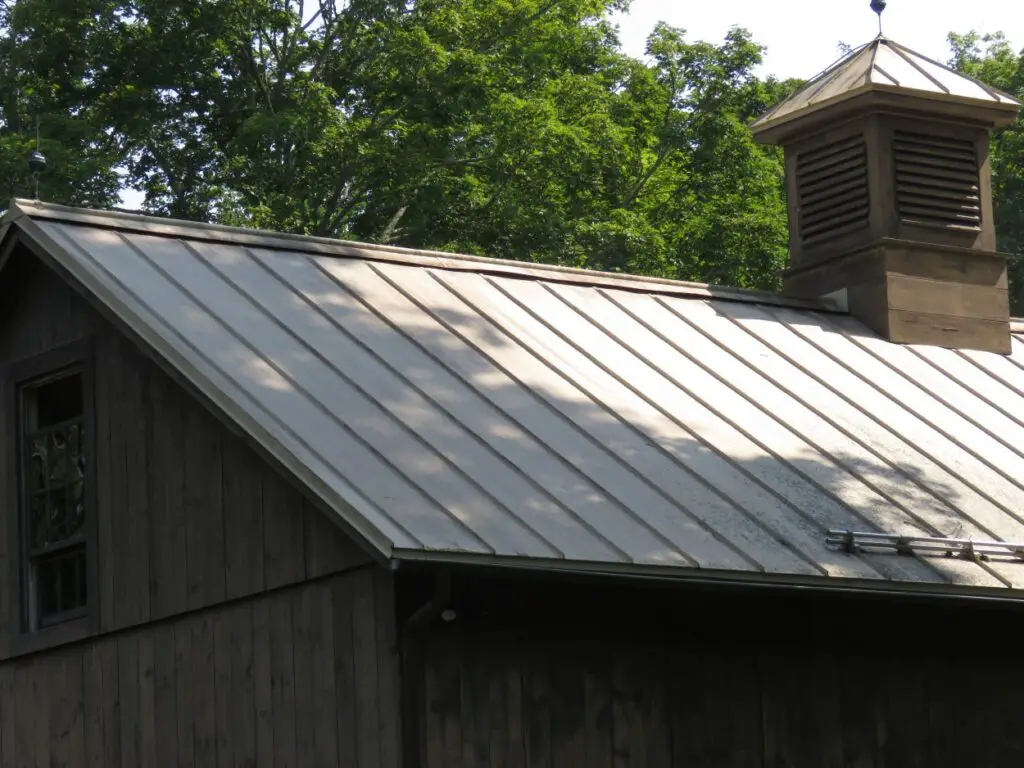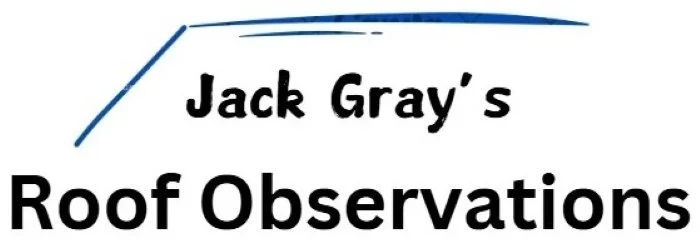Also see: Roof Cost Calculator
Table of Contents

Introduction
I’ve done a lot of research on roof replacement costs for my clients over the years, and I still do. I keep up-to-date with changing material and labor costs for all kinds of roofing, including steel roofs. I thought keeping an accurate, updated table of steel roofing cost estimates online would be a helpful resource for me, my clients, and homeowners in general. The tables on this page show estimated costs, including labor and materials, for replacing a roof with various types of steel roofing.
Steel is one of the most widely used roofing materials in North America. One of its biggest advantages is its strength and structural stability. Steel roofing panels are typically galvanized or coated with protective finishes like PVDF (Kynar) to resist corrosion and extend service life. While steel does not offer the same inherent corrosion resistance as the other metals used for roofing, properly coated steel performs well in most environments and it’s a relatively cheap and durable roofing material. In coastal or other corrosive environments, steel roofing requires careful maintenance to ensure its coating remains fully intact, and you may want to seriously consider aluminum roofing instead.
Steel is more affordable than aluminum or copper, making it attractive for budget-conscious homeowners looking for a long-lasting roof. While a steel roof generally won’t last as long as an aluminum roof under the same conditions, most high-quality steel roofing systems can still provide 40 to 60 years of service life. Steel is also recyclable, and many steel roofing products include a high percentage of recycled content.
The cost of a steel roof varies depending on roof size, pitch, complexity, local labor rates, and the specific style of steel roofing system selected. Product quality also plays a big part. If you’re interested, you can see who I think makes the best metal roofing products.
The estimated prices I provide here are averages intended to give you a ballpark idea of what a steel roof might cost. So on average, the cost of a steel roof in 2025 ranges from around $8.25 per square foot for exposed fastener panels to about $12.75 per square foot for standing seam steel systems. Steel shingles typically cost around $10.50 per square foot.
For an average 1,700-square-foot roof, total installed costs range from approximately $14,025 for exposed fastener panels to about $21,675 for standing seam steel. A steel shingle roof of the same size would cost about $17,850.
See my more general Metal Roof Cost Guide if you’re interested in other types of metal roofing.
Also see my Roof Replacement Cost Guide, which has typical current roof prices for other residential and commercial roofing materials.
Types of Steel Roofing
The tables below give typical steel roof prices according to the type of steel roofing system. There are several different types of steel roofing, and the specific system chosen will affect the roof’s cost, performance, appearance, and lifespan.
All types of steel roofing begin with cold-rolled steel coil, which is then coated using a process called hot-dip metallic coating. In this process, the steel is passed through a bath of molten metal to apply a corrosion-resistant metallic coating: either a galvanized (zinc) or Galvalume® (zinc-aluminum-silicon) coating.
Galvanized steel is coated with a layer of pure zinc, which provides sacrificial protection against rust by corroding in place of the underlying steel. Galvalume steel, on the other hand, is coated with a zinc-aluminum alloy (typically 55% aluminum, 43.4% zinc, and 1.6% silicon), which provides even better corrosion resistance, especially in environments with high humidity or salt exposure.
After the base steel is coated, the panels are typically finished with a factory-applied paint or protective coating such as SMP (silicone/polyester) or PVDF (Kynar). These coatings come in just about any color a customer might want.
Steel roofing systems, regardless of type, are valued for their strength, affordability, and durability. Steel roof panels will almost always come painted with corrosion-resistant coatings and factory-applied finishes. Steel roofs come in a wide range of profiles and colors, from utilitarian exposed fastener panels to more leak-resistant standing seam systems and decorative stamped shingles. To learn more about different systems and see what they look like, take a look at a few steel roofing manufacturer websites.
Standing Seam Steel Roofs
Standing seam steel roofs are a popular and widely used option for residential and commercial applications. These roofs are defined by prominent raised vertical seams between the panels that run from the ridge down to the eaves. These “standing” seams conceal the fasteners that secure the panels to the roof deck, protecting them from the elements and reducing the risk of leaks at fastener locations (one of the primary concerns with exposed fastener systems).
Standing seam steel panels are typically available in widths ranging from 12 to 24 inches, and can be roll-formed on-site or factory-produced, depending on the project. The concealed fastening system not only improves weather resistance but also allows the panels to freely expand and contract in response to temperature changes. This thermal movement is especially important in steel systems, which expand and contract more than some other roofing materials. When properly installed with sliding clips or floating systems, standing seam steel roofs perform reliably over decades with minimal maintenance.
Read more about standing seam roof costs.
Exposed Fastener Steel Panels
Exposed fastener metal roof panels are also known as through-fastened panels, screw-down metal, ribbed panels, utility panels, R-panels, or may sometimes just be loosely called “corrugated panels.”
Exposed fastener steel roofing is one of the most affordable and widely used steel roofing systems. It features long panels that are secured directly through the face of the panel to the roof deck or purlins using specialized screws with rubber washers to keep the water out. The fasteners remain visible after installation, giving the roof a more industrial or utilitarian look compared to concealed fastener systems like standing seam.
This type of steel roofing is frequently used on barns, agricultural buildings, cabins, garages, and lower-cost residential projects. While it is cheaper, it requires precise installation to ensure long-term watertight performance, as every fastener location becomes a critical point of potential leaking if the fasteners are not installed correctly. And over time, the rubber washers can degrade due to UV exposure, leading to potential leaks if not properly maintained or replaced.
Steel panels used in this system typically range from 24 to 36 inches wide and up to 30 feet long. Longer and wider panels allow for fewer seams and faster installation, but longer and wider panels may experience other issues, such as oil canning.
Steel Shingles
Steel shingles are relatively small, interlocking metal tiles that are installed in horizontal courses using concealed fasteners. The bottom edge of each steel shingle hooks over the top hem of the shingle below it. Fasteners are typically installed along the upper edge and hidden by the next row, while interlocking side flanges connect adjacent shingles for added stability and weather resistance. Steel shingles provide the appearance and long-term durability of metal roofing in a format that many homeowners find more visually appealing. They are often stamped and painted to mimic the look of slate, cedar shakes, or dimensional asphalt shingles.
Steel shingles are typically quicker and easier to install than custom-formed standing seam panels and don’t require seam-forming tools or specialized equipment on-site. This can help reduce labor costs and simplify the installation process. While they remain a premium option compared to asphalt shingles, they generally cost less than standing seam steel systems.
Steel Panel Thickness (Gauge)
Steel roofing panels are manufactured in standardized thicknesses referred to by gauge, with lower gauge numbers indicating thicker, stronger steel (you can read more about sheet steel gauge here). Unlike aluminum, steel gauge is more consistent across manufacturers and follows an established scale, making it easier to compare products.
Common steel panel gauges used for residential roofing include:
- 29 gauge (≈ 0.014–0.015 inches) – The thinnest steel typically used for roofing, most often found in budget-grade exposed fastener panels. Suitable for sheds, barns, and other utility structures but more prone to denting and deformation.
- 26 gauge (≈ 0.017–0.018 inches) – A common choice for higher-quality exposed fastener panels and some standing seam systems. Offers a good balance of strength and affordability for residential use.
- 24 gauge (≈ 0.023–0.024 inches) – The preferred thickness for architectural-grade standing seam steel roofing. Provides excellent durability, resistance to hail, and reduced risk of oil-canning.
- 22 gauge and thicker – Occasionally used in commercial or structural applications where higher wind uplift or impact resistance is required. Considered overkill and rarely used in standard residential projects due to the added cost and weight.
Key Points:
- Heavier gauge steel panels (24 and 22 gauge) provide better resistance to hail, wind uplift, and foot traffic, but come at a higher material cost.
- Lighter gauge panels (26 and 29 gauge) are more affordable and easier to handle, but may be more vulnerable to denting and deformation, especially in severe weather regions.
- Unlike aluminum, steel roofing can rust if coatings are damaged or deteriorate. That makes the choice of protective finish just as important as the gauge.
- Using 24 gauge steel instead of 26 gauge can increase material cost by 10 to 20%, but may be worth it to get a higher-performing roof.
Things to Keep in Mind
These steel roof cost estimates should be fairly accurate; I make an effort to regularly update them using current material prices and labor data.
Keep in mind that the costs listed below are national averages, and actual prices can vary significantly depending on your location. To get a more accurate idea of what a new steel roof will cost in your area, see “Relative Construction Costs by U.S. State” and apply your local multiplier to the national average cost.
The steel roof cost estimates provided here assume installation on roofs with a 6/12 pitch or less and include all standard steel roof components. Steeper roofs or roofs with complex geometry may increase labor costs by as much as 50%. The removal of an existing roof typically adds $1 to $3 per square foot, depending on roof type and number of layers. I included $1.50 per square foot for roof removal in the cost estimates in the table.
These tables assume the use of SMP-coated steel panels or stamped steel shingles of standard gauge and finish. Upgrading to a heavier gauge steel or a premium PVDF (Kynar) finish will generally increase material costs by 10 to 25 percent, depending on the product and supplier.
Table 1: Steel Roof Cost per Square Foot
| Average Cost of a Steel Roof | |||
|---|---|---|---|
| Type of Steel Roofing | Average Installed Cost Per Square Foot |
Average Installed Cost Per Square (100 sq. ft.) |
Average Installed Cost Average Roof (1700 sq. ft.) |
| Steel Shingles | $10.50 | $1,050 | $17,850 |
| Steel Shingles (PVDF/Kynar Coated) | $13.10 | $1,310 | $22,275 |
| Exposed Fastener Steel Panels |
$8.25 | $825 | $14,025 |
| Exposed Fastener Steel Panels (PVDF/Kynar Coated) | $10.30 | $1,030 | $17,530 |
| Standing Seam Steel Panels |
$12.75 | $1,275 | $21,675 |
| Standing Seam Steel Panels (PVDF/Kynar Coated) | $15.90 | $1,590 | $27,090 |
Table 2: Steel Roof Cost by Roof Size
| Steel Roofing Cost by Roof Size | |||
|---|---|---|---|
| Roof Area | Steel Shingles | Exposed Fastener Steel Panels |
Standing Seam Steel |
| 750 SF | $7,875 | $6,185 | $9,555 |
| 1,000 SF | $10,500 | $8,250 | $12,750 |
| 1,250 SF | $13,125 | $10,310 | $15,935 |
| 1,500 SF | $15,750 | $12,375 | $19,125 |
| 1,750 SF | $18,375 | $14,435 | $22,305 |
| 2,000 SF | $21,000 | $16,500 | $25,500 |
| 2,250 SF | $23,625 | $18,560 | $28,685 |
| 2,500 SF | $26,250 | $20,625 | $31,875 |
| 2,750 SF | $28,875 | $22,685 | $35,060 |
| 3,000 SF | $31,500 | $24,750 | $38,250 |

